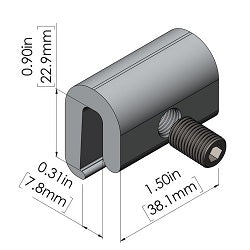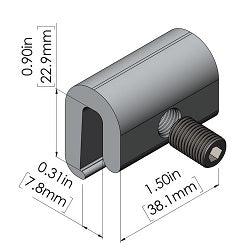SKU: 54000034 | S-5!
WindClamp UD (Ultra-Deck)
WindClamp UD (Ultra-Deck)
| Qty | Price |
|---|---|
| Buy 800 | $2.90 Each |
Couldn't load pickup availability

Shipping Details
At Rapid Materials, we prioritize quick and efficient order processing to meet your needs.
Our team is available Monday–Friday, 8 AM to 5 PM EST, ensuring your orders are handled promptly. We’re dedicated to delivering your materials as quickly as possible. Have questions? Don’t hesitate to reach out—we’re always happy to assist!
Standard Shipping
- Orders placed by 1 PM EST are processed within 24 business hours and typically ship the same day.
- Orders received after 1 PM will ship the next business day.
Expedited Shipping
- For expedited orders, we’ll do our best to ship them the same day—even if placed after 1 PM EST.
Holiday Shipping
- We do not process or ship orders on major holidays.
- Some locations close during the last two weeks of the year for inventory processing. Specific details will be noted on product pages.
Please note: Some products may require additional handling time and will take longer than 24 hours to ship. For specific shipping details or lead times, refer to the individual product page or contact us directly—we’re here to help.
-
Description
What is an S-5! WindClamp™?
A wind clamp, otherwise known as an “external seam clamp,” is a small aluminum clamp placed over the seam at given intervals to prevent male-to-female seam separation and/or seam separation from its mounting clip.
The wind clamp significantly increases the wind-resistance capacity of the panel system. It can also help prevent clip disengagement when used at clip locations.
Actually, any of our seam clamps will improve wind resistance of the roof and can be used for that purpose. S-5! WindClamps, however, are specially designed solely for this purpose on select concealed-fastened seam profiles, so they are even more effective and more economical in quantity.
Why Install WindClamps on Your Metal Roof?
Design wind speeds and code requisites are upgraded over the years. What is a building owner to do upon discovering that his roof is no longer code-compliant and may be in danger of wind damage or blow-off?
In some situations, the application of wind clamps is highly engineered and extensively tested, while in others it is a “prescriptive” remedy. S-5! offers cost-effective solutions in both categories. They can preserve the roof’s integrity while significantly upgrading its wind uplift resistance as much as 3X for pennies per square foot of roof area.
What Are the Advantages of Installing WindClamps?
Cost-Effective Solution for Existing Construction
- Far less intrusive; no disruption to building occupants
- Less costly than roof replacement
-
More cost-effective than alternative methods of improving wind resistance such as:
- Adding clips and structure
- Increasing panel gauge or decreasing seam spacing
Increase Resistance of Roof Uplift Loads
- Allows the use of standing seam roofs in new construction when the roof alone does not meet requisite wind-suction pressures.
- Offers an increase in failure pressures as much as 300% depending on panel profiles, gauge, and purlin spacing.
- Can bring existing construction into ASCE 07-16 code compliance with minimal expense and without costly structural changes (ASCE 07 is the consensus standard used to determine design loads for building design).
-
Brand
S-5!S-5! has led metal roof attachment since 1992, with zero-penetration clamps and brackets that preserve roof integrity and warranties.Shop more from S-5! →Specs
- SKU: 54000034
- UPC: 810099471472
- Choosing a selection results in a full page refresh.
- Opens in a new window.



